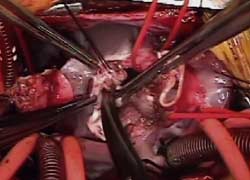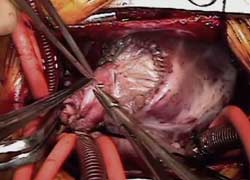

1. Full circumferential mobilization of the aortic root minimizes tension on the coronary arteries, thus avoiding the need for coronary artery re-implantation.
2. Division of the ascending aorta allows the Lecompte maneuver, which protects bilateral pulmonary arteries from potential obstruction.
3. Nearly one third (7 of 24) of cases did not need a VSD patch as in the case in the video, when the right ventricular outlet wall below the aortic annulus covers the defect.
4. The large area from which the original aortic root is mobilized can be covered with a crescent-shaped patch, and the main pulmonary artery can be implanted to this patch with an ample opening. The ASD should be closed in the usual manner.
Since the operation requires a prolonged aortic cross clamp time, single dose Custodiol® cardioplegia was considered to be suitable for myocardial protection. The patient was a 14 month-old girl, who weighed 7.3 kg, and measured 72 cm in height (BSA 0.37). The aorta was cannulated high, just proximal to the origin of the innominate artery, with a 10 Fr cannula. Bicaval cannulation was done with 12 and 14 Fr right angle venous cannulae. Upon aortic cross clamp, 292 ml (40 ml/kg) of Custodiol® at 3–4 degrees Celsius was injected through an 18 gauge DLP catheter under pressure at 100 mmHg. The left heart was vented with a 10 Fr. DLP ventricular vent inserted from the right pulmonary vein. Moderate hypothermia with rectal temperature at 22.8 degrees and flow rate of 2.0–2.4 L/m2 were utilized. Cardiopulmonary bypass lasted 162 minutes and the aortic cross clamp time was 124 minutes. Upon removal of the aortic clamp, sinus rhythm was regained.
The patient was extubated the next morning and the only inotropic infusion (milrinone) was discontinued. She was discharged to home on the fifth postoperative day on furosemide and non-narcotic analgesics.



